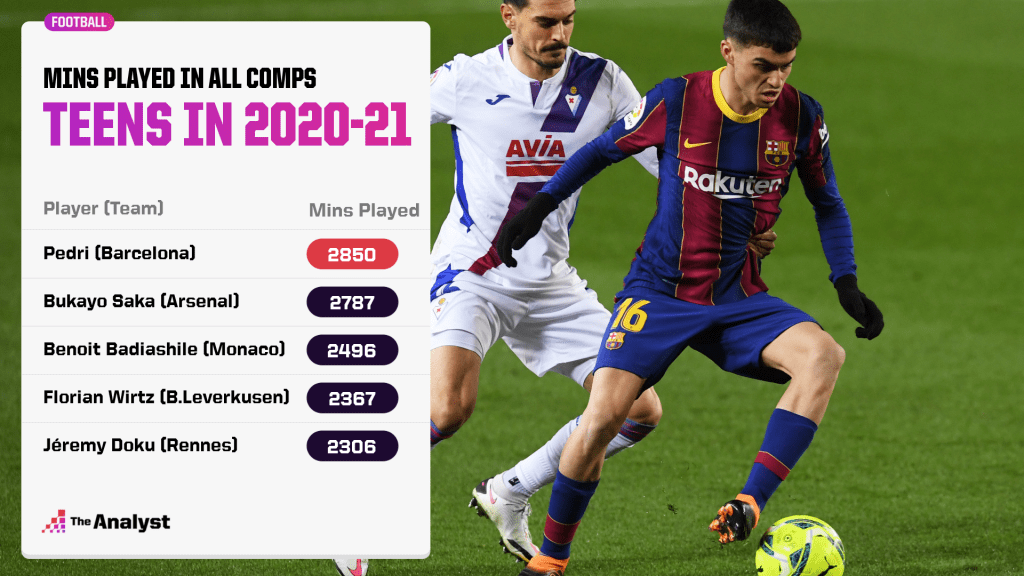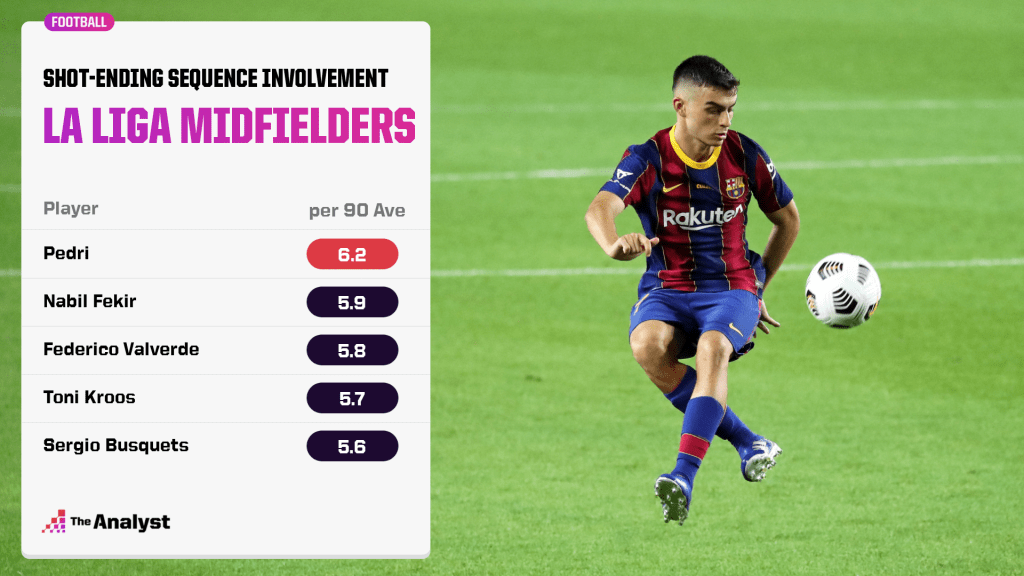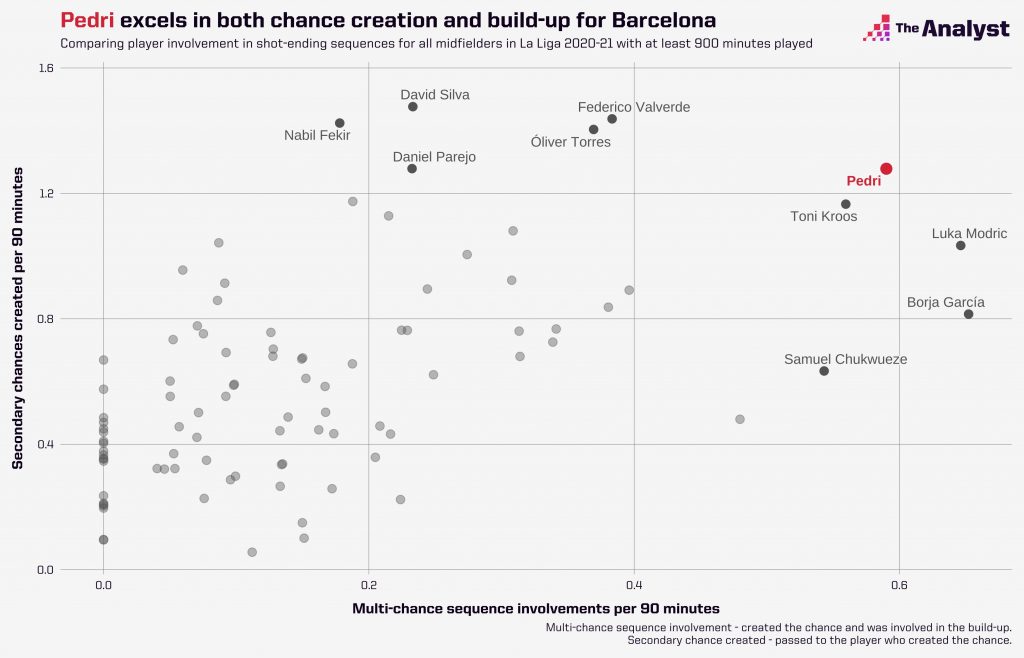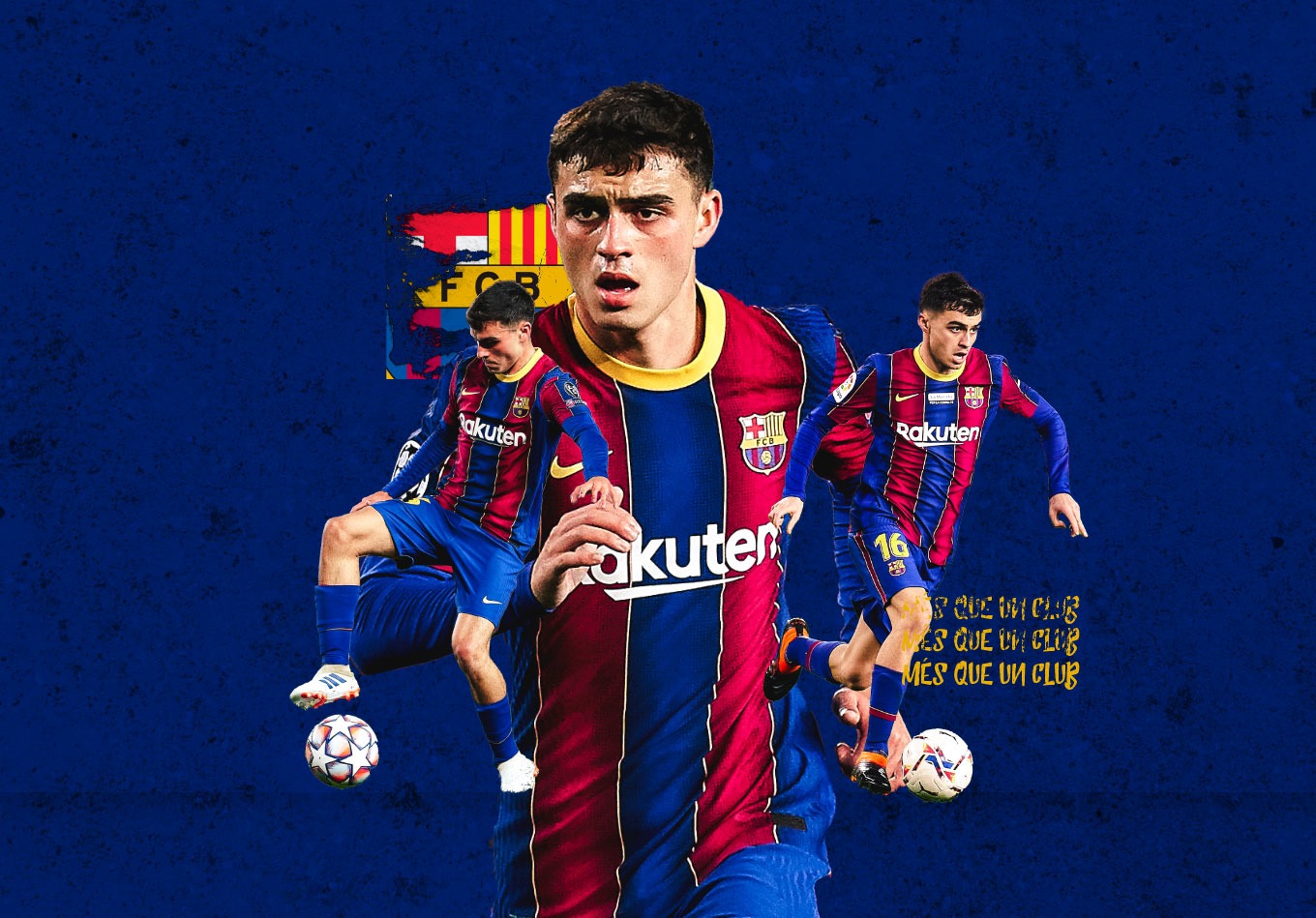It’s been a life-changing 18 months for Pedri. Plucked from second-tier club Las Palmas, the midfielder has become an integral part of Barcelona’s midfield in 2020-21 and made his Spain debut last week. Comparisons to Barca legend Andrés Iniesta have naturally been made, but how far can the new kid on the block go?
This paragraph is meant to be read quickly: A 16-year-old Pedri becomes a Las Palmas fixture, is the following season signed by this club Barcelona you may have heard of, immediately plays himself out of the club’s loan plans, plays himself into his own plans of becoming an indispensable starter at Barca and is now a senior Spanish international. All this between the age of 16 and 18.
OK, take a breath and let us explain.
Yes, Pedri was just 16 years old when he was named in Las Palmas’s starting XI on the opening day of last season. In the Segunda División – Spain’s second tier – the stereotype of the country’s intricate, passing football often goes in direct contradiction to the actual style of play. And physically, Pedri looked entirely unqualified to have been thrust into such an environment.
What people couldn’t see on the surface – as was soon to be revealed – was a level of intelligence that breaks all correlation to his age and experience. The teenager is a master interpreter of the ball, in its relation to time and space, while his diminutive frame helps him more as a tireless runner than it impedes him in physicality.
There had been little external expectation that Pedri would have a part to play in Barcelona’s present. After joining up with the club in preseason, however, the club’s initially reported plans that had centred around him leaving on loan – possibly back to Las Palmas for not only one, but multiple seasons – were soon abandoned. In choosing the direction of the team, new manager Ronald Koeman had been intrigued enough to think his career at the Catalan club could begin immediately.
Since that day in August 2019 when Pedri took his first professional step, his ascent has defied convention.
It was once assumed that Barcelona would have to grow their own heirs to the likes of Xavi and Andrés Iniesta internally, without any indication of when the next talents of this mould would come along, but Pedri offers an unexpected alternative. Signed for just an initial €5 million, Barcelona have reason to hope their midfield excellence from a former generation is possible again, and much sooner than they could have imagined.

Pedri has featured in 42 of Barcelona’s 43 games under Koeman. The only one he failed to appear in was away to Ferencváros in the Champions League group stage – a game that he started on the bench, while the Blaugrana were 3-0 up after 28 minutes. In the most consequential games of the season, the teenager has been front and centre with Barcelona’s core players.
His 42 appearances for the club have equated to 2,850 minutes of playing time – the most of any teenager in the top five European leagues this season, across all competitions. This carries extra significance in that the Tenerife-born midfielder won’t even turn 19 until next season.
So he’s 1.) young. 2.) good. You get it. Onto the details.
What Makes Him so Special?
Since his talents became obvious at Barcelona, Pedri has repeatedly been compared to one player: Andrés Iniesta. As a youngster growing up in Tenerife, Iniesta was his footballing idol and the example he tried to follow. As Pedri has referenced in personal interviews, his affinity for the club legend went as far as to ask his dad if he could have the same haircut as him.
The request was denied, but he fortunately shares plenty of his idol’s more important features. “I’m timid off the pitch, but I have fun on it,” Pedri admits. With Iniesta, he shares the same temperament, the same cerebral nature that so often typifies the players who transcend the midfielder tag to become virtuosos.
The great irony of Iniesta’s career is that despite scoring the most important goal in Spanish football history – the winner in the 2010 World Cup final – he was never overtly influential in scoring goals or being a chance-generating machine. Pedri’s debut season at Barcelona has followed a similar trend and wouldn’t be accurately depicted by focusing only on his tally of three goals and six assists.
For a player like Pedri in a possession-based system, sequence data allows us to dig deeper into his effect on Barcelona’s collective play. Sequences are defined as passages of play which belong to one team and are ended by defensive actions, stoppages in play or a shot.
Among the group of midfielders with 900+ minutes played in La Liga this season, Pedri leads all eligible players for shot-ending sequence involvement per 90 (6.2). This speaks to his role in facilitating Barcelona’s attacks and acting as conduit of play, as opposed to being directly involved in the defining actions at the end.
Factoring in the expected goal (xG) value of these sequences on a per-90 basis – in order to highlight the quality of the shots they produce – Pedri ranks third in the same group of players (0.8), marginally behind Fede Valverde and Frenkie De Jong.

The beauty of Pedri’s play lies in his versatility in the varying phases of possession. In the build-up, he appears as a willing receiver who possesses enough smarts to navigate under pressure and preserve Barcelona’s continuity on the ball.
Build-up play is defined as an open-play sequence that contains 10+ passes and either ends in a shot or a touch in the box, and Pedri ranks second in La Liga among midfielders with 900+ minutes played for build-up sequence involvement per 90 (3.8). The only midfielder ahead of him is teammate Sergio Busquets (4.3), who operates close by as a deeper option and often anchors the build-up in the initial stages.
Writing in the newspaper El Pais, Jorge Valdano – one of the Spanish game’s great articulators in his post-playing career – joked that Pedri is so embedded in his role as “everyone’s associate” that he sometimes gets into the opposition penalty area and forgets there’s a net, while he carries on distributing.
Valdano’s insight was a playful way of highlighting Pedri’s unselfish tendencies, and only came after describing him needing “(only) a glance to see football in cinemascope.”
While there is some truth to Pedri’s auto-pilot combination passing, the 18-year-old has still been one of La Liga’s most effective players in pairing general probing with more decisive passes. Pedri’s tally of three La Liga assists this season doesn’t quite reflect his creative ability. Even in a team blessed with Barcelona’s attacking talent, there’s no guarantee your handy work will be finished off.

Pedri has recorded 12 multi-chance involvements in La Liga, ranking him second only to Luka Modric (15) among all midfielders. This metric is related to the aforementioned sequence data, capturing all the instances where a player was both involved in the build-up sequence and also created a chance for a teammate later in the chain.
Another closely related area in which Pedri excels is the pass before the killer pass – a defining feature of Barcelona midfield greats from previous generations. In other words – as defined by our secondary chance created metric – the pass that sets up the player who assists the eventual scorer. Only Lionel Messi has made more for Barcelona than Pedri (26) in La Liga this season, with the teenager residing firmly amongst the best of the rest across the division in Messi’s wake.

Wherever on the pitch Barcelona have the ball, Pedri is notable for his capability of association. From build-up play to creating chances in the final third, or whether just in their classic style of ball retention – where they simultaneously probe for openings while defending, by means of hogging the ball – Pedri is already a vital part of allowing Barcelona to be Barcelona.
After scoring his first Champions League goal last October at just 17 years, 330 days old versus Ferencváros, Pedri was filmed leaving the Camp Nou for home in the back of a taxi. It was an alternative reminder, just in case anyone had started to forget, just how remarkable his emergence within the European colossus was primed to be. Pedri wasn’t yet old enough to legally own a car in Spain.
Growing up in the Canary Islands, Pedri had been merely one of millions around the world watching Barcelona in admiration. Along with his idol Iniesta, Messi was the same mythical figure to Pedri that he remains to so many across the planet. The only difference in his case is that not only has he since climbed inside his TV set, but he’s already developed a chemistry with Messi that few ever have.
Although they come from different ends of the spectrum – in experience, in achievement, in notoriety – they share a football language. Barcelona’s master has a new apprentice in tow. One who could define Spanish football’s coming generation.
Design by Matt Sisneros.
